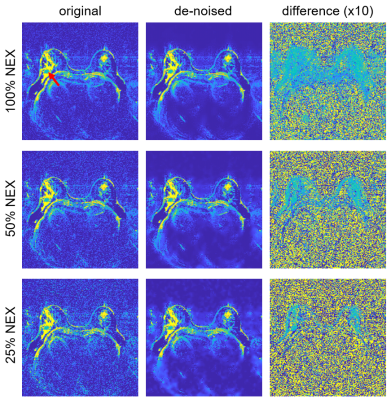Patrick J Bolan1, Jessica A McKay2, Mehmet Akcakaya3, An L Church4, Michael T Nelson4, Kamil Ugurbil1, and Steen Moeller1
1Radiology / Center for Magnetic Resonance Research, University of Minnesota, Minneapolis, MN, United States, 2Radiology, Stanford University, Palo Alto, CA, United States, 3Electrical and Computer Engineering /CMRR, University of Minnesota, Minneapolis, MN, United States, 4Radiology, University of Minnesota, Minneapolis, MN, United States
1Radiology / Center for Magnetic Resonance Research, University of Minnesota, Minneapolis, MN, United States, 2Radiology, Stanford University, Palo Alto, CA, United States, 3Electrical and Computer Engineering /CMRR, University of Minnesota, Minneapolis, MN, United States, 4Radiology, University of Minnesota, Minneapolis, MN, United States
This study describes the application of a low-rank denoising
technique (NORDIC) on quantitative breast DWI. We found that this increased the
accuracy and reproducibility of ADC maps, especially in low-SNR regions of the
images.

Fig 1: Example ADC maps from standard DWI scan, showing
full acquisition (top row) and retrospectively shortened scans (middle and
bottom row). The columns show the original scan (left), with low-rank denoising
(middle), and the difference (right). Note the low-ADC tumor indicated by the
red arrow.

Fig 2: Patch-based
analysis showing the impact of NORDIC on ADC maps as a function of SNR. For
this example, all 40 ADC slices from a single subject were divided into 12x12
pixel patches, and the mean absolute difference between original and denoised
patches was plotted as a function of SNR. The black line is a filtered moving
average. In the full acquisition (A) the greatest impact of denoising is for
patches with SNRdB<10, with the effect decreasing with increasing
SNRdB. In the abbreviated acquisitions (B, C) the overall SNR is
lower and more patches are affected by the denoising operation.